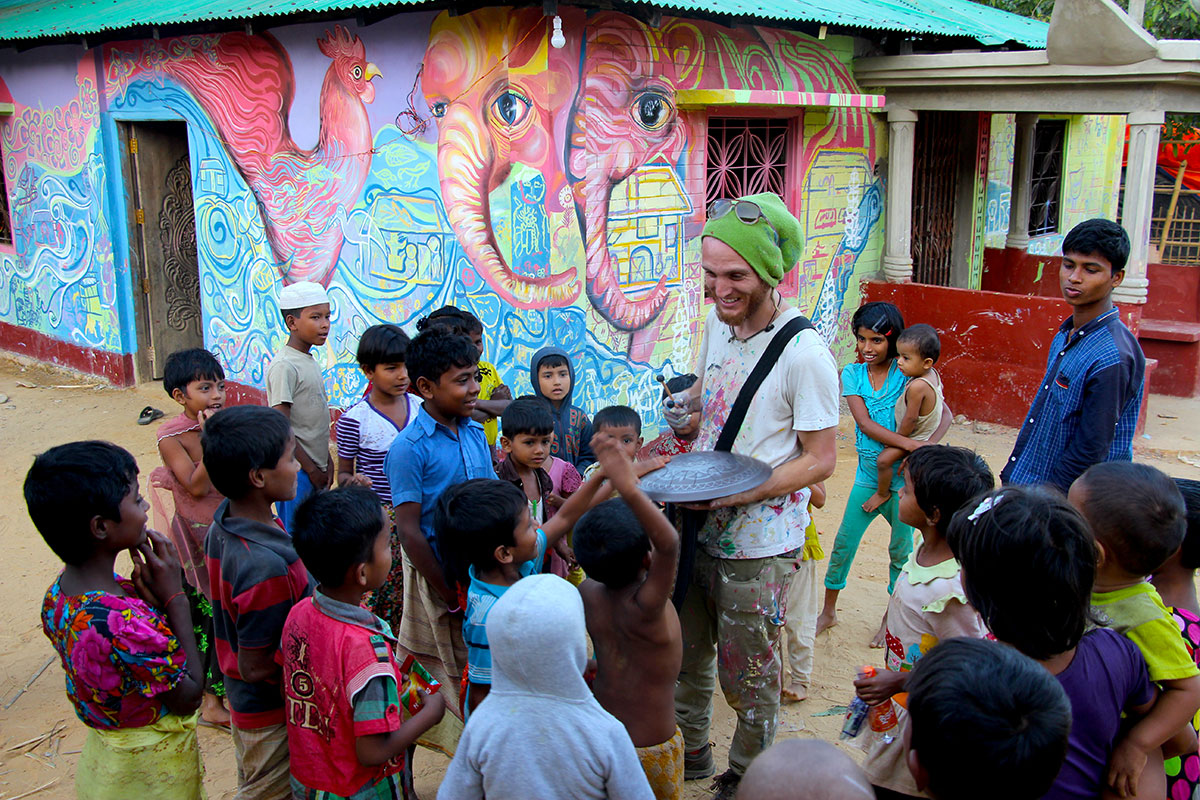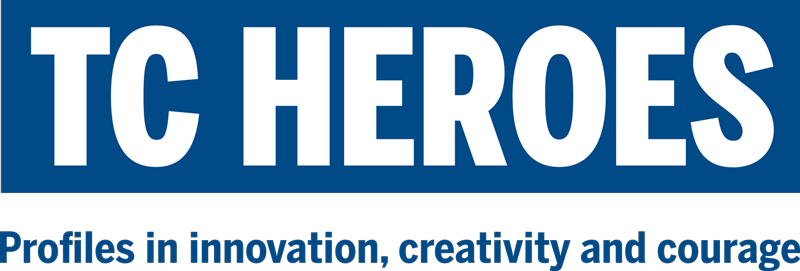Three years ago, during the first of his five extended visits to Kutapalong and Balukhali Refugee Camps in Bangladesh — home to more than 1 million Rohingya refugees who have fled a decades-long genocide waged by the government of Myanmar — Max Frieder spent six weeks going door-to-door, asking anyone and everyone if they knew any artists. The answer, day after day, was that there were no artists in the camp — they simply did not exist.
“I said, ‘that’s impossible, every culture has artists,’ but people told me no, in Myanmar, Rohingya aren’t allowed to be artists. It was like talking to Jews who escaped from Germany under Hitler. They said that at first, they had been allowed to study only certain subjects. Then none. Then they were not allowed to marry. In 1982, the Citizenship Law was passed, specifying that there were 172 official races in Myanmar, and the Rohingya were not one of them. So they had no rights.”
Max Frieder: Ed.D., Art & Art Education
Eventually Frieder did find some artists. One had drawn on scraps of garbage with charcoal while his family was in hiding. Another had hidden his Rohingya identity, gone to school, and learned to draw diagrams. A third had practiced breakdancing alone, in hiding.
“You really can’t make this stuff up,” says Frieder, who received his Ed.D. in Art & Art Education in May.
I said, ‘that’s impossible, every culture has artists,’ but people told me no, in Myanmar, Rohingya aren’t allowed to be artists. It was like talking to Jews who escaped from Germany under Hitler.
— Max Frieder
It would be equally hard to dream up Frieder himself, or Artolution, the nonprofit he co-founded, which creates art around the world with refugees, street youth, the incarcerated, people with physical and mental disabilities, and young people living in areas of violent conflict or extreme poverty. Artolution is active in eight regions globally, and has major projects ongoing in refugee camps and host communities in Uganda, Colombia, Jordan and Bangladesh. Frieder has personally led the latter, building a team of Rohingya visual artists and musicians who are creating culturally relevant messaging around issues of human rights, gender-based violence, host-refugee relations and — especially critical right now, in light of the COVID crisis — public health.
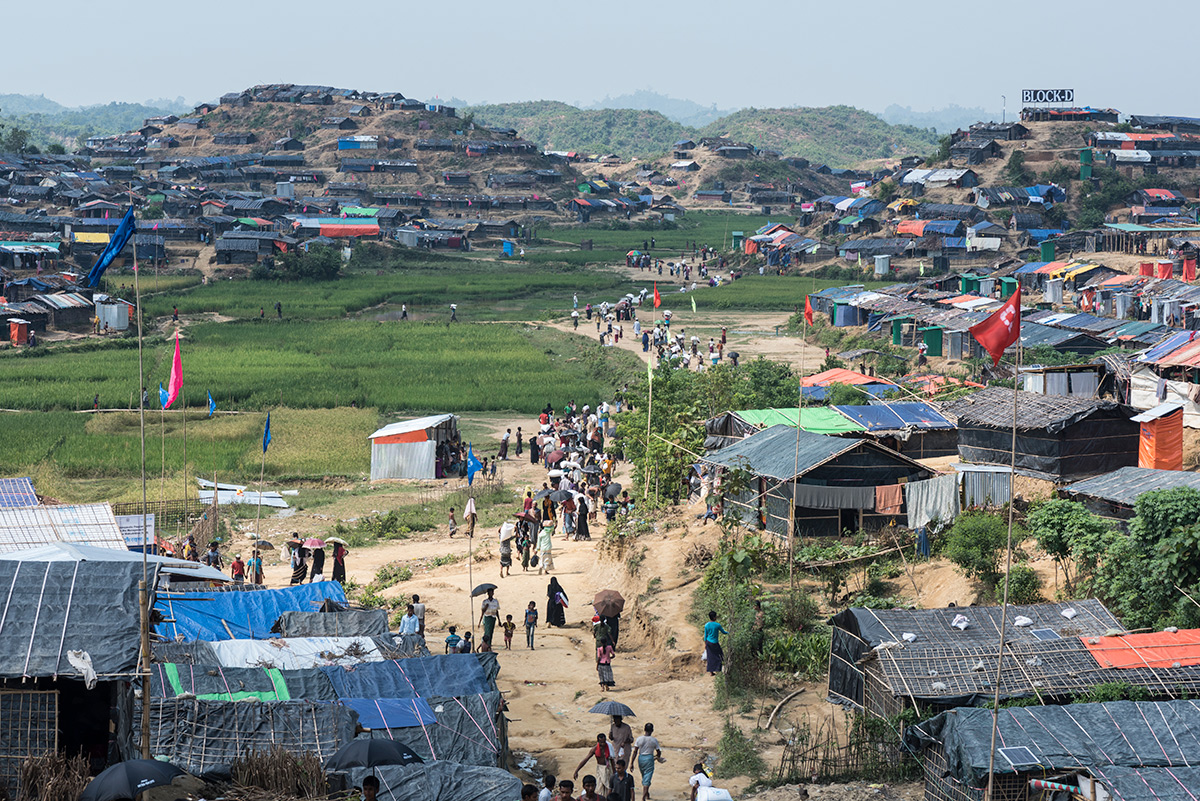
DIRE SITUATION The population density in the Rohingya refugee camps in Bangladesh make COVID an even greater threat. (Photo: TC Archives)
“The situation is so dire,” he says. “You’ve got over a million people living in a tiny area, with families of up to 14 in small shacks. The population density is extreme, so it’s potentially really deadly.” Indeed, since the first COVID-19 case was diagnosed in the camps in mid-May, hundreds of people have contracted the virus, and a recent modeling study by researchers at the Johns Hopkins Bloomberg School of Public Health predicts that, if unchecked, the virus could infect up to 98 percent of the population within the first year after the initial outbreak. Compounding the challenge: The Rohingya have no written language, and most men and nearly all women are illiterate in any written form.
That makes visual imagery critically important. On the most immediate level, Artolution’s artists are spreading the word about basic issues: where to get care if a baby is sick; how to properly wash hands before eating; latrine hygiene; simple coping mechanisms for the traumas people have endured. They’re also educating a wider audience about their community’s plight: In 2018, Frieder and his Artolution co-founder, Joel Bergner, arranged with UNICEF for a Rohingya exchange mural to hang in New York City’s Oculus Building, which sits adjacent to the memorial site for the 9/11 terrorist attacks.
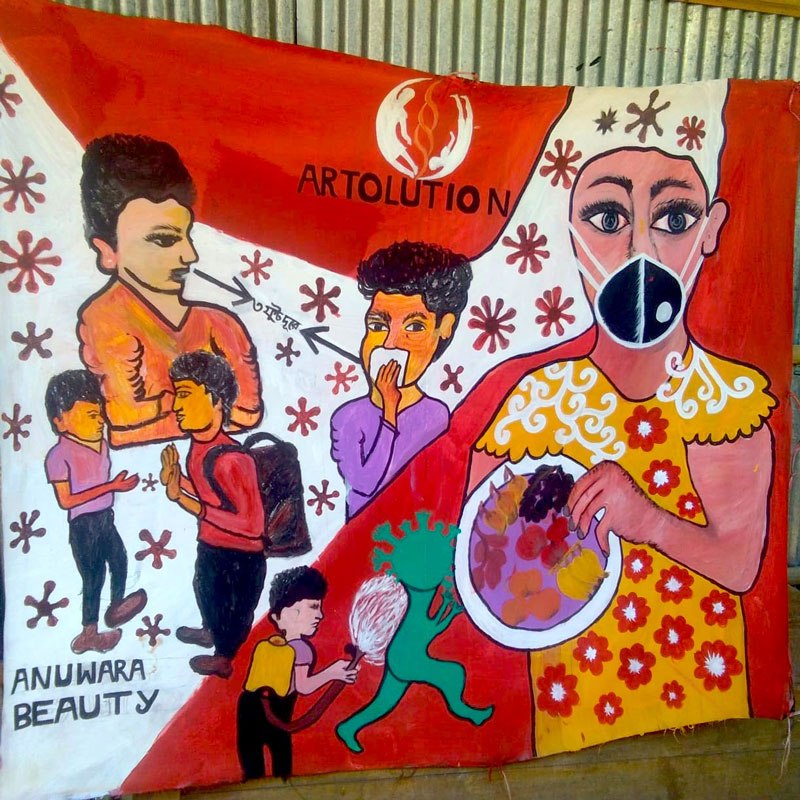
WORTH A THOUSAND WORDS The Rohingya have no written language, making art a critical medium for public health messaging. (Photo: TC Archives)
But through their work, he believes, something much more profound is also taking place.
“We gave them ownership,” he says. “They’re not working for me — it’s their movement. Working with us and UNHCR [United Nations High Commissioner for Refugees], they created the first arts center in the history of the Rohingya, right in the middle of the camp. They can tell their own stories, make their own histories. For a community that has had their history ripped from them — that’s undergone a cultural as well as a physical genocide — that opportunity is huge.”
We gave them ownership — it’s their movement. They can tell their own stories, make their own histories. For a community that has had their history ripped from them — that’s undergone a cultural as well as a physical genocide — that opportunity is huge.
— Max Frieder
With his shaggy mane of blondish hair, backpack and friendly grin, Frieder looks every inch the Colorado native and Rhode Island School of Design graduate that he is. He credits his mom, a first-grade teacher and children’s book author, and his dad, a sculptor and former commercial construction manager who spent months cycling around the world, for his artistic talent, adventurousness and belief in social justice. To that mix, he adds his own boundless energy and the shrewd political instincts that have enabled him to forge ties with officials in the United Nations and the Red Cross, the actress Katie Holmes (now an official Artolution Ambassador), the social activist artist JR, and the international artist and Artolution Ambassador Vik Muniz, who has twice accompanied Frieder to the Rohingya camps to make a documentary about Artolution’s work there. Last year, Frieder was among the keynotes at UNESCO’s international conference, where he followed singer and record producer Andrea Bocelli to the podium. When he finished speaking, Dipu Moni, the Bangladeshi education minister, tearfully embraced him on stage, declaring, “You talked about our country, and no one thinks about us.”
Graduates Gallery 2020
Meet some more of the amazing students who earned degrees from Teachers College this year.
But ultimately, Frieder sums up his approach with two very simple words: Being there.
“To quote Mary Mendenhall — do no harm,” he says, referring to TC Associate Professor of Practice Mary Mendenhall, acting chair of the Department of International & Transcultural Studies. (He calls Mendenhall, a globally recognized authority on refugee education, Lena Verdeli, Director of TC’s Global Mental Health Lab, and his doctoral sponsor, Judith Burton, Macy Professor of Education, “the three women who have changed my life.") “And sometimes if you don’t come back, you do more harm. Initially, the Rohingya teaching artists didn’t know whether to trust me. I was this crazy foreigner, and they didn’t think I’d come back after the first visit. When I did, three months later, that was a big turning point. They were really surprised that the co-founder is going to spend months knee-deep in the mud, carrying paints because the tuk-tuk can’t go there. I was making sure they understood that they are not lower than me. That there’s an equity to how we function.”
By then he’d arranged for the artists to get paid by funding organizations (“that’s crucial — that’s how they put food on their tables”) and persuaded them to recruit others — including, importantly, women, who traditionally have little agency within the Rohingya community, but have artistic experience through hennaing their hands or pattern-making with fabrics. The team grew to work in women-only work spaces and eventually, in collaboration with United Nations Population Fund, helped publish a book called “The Colorful Sky Lantern” — murals painted by women who had endured sexual or gender-based violence.
We consider protecting women and improving their standing to be as important as our goals around COVID. One of the hardest parts of my job is confronting the men we work with about domestic violence. We tell them, ‘If we catch you hitting a child or woman, you won’t have a job.’
— Max Frieder
“We consider protecting women and improving their standing to be as important as our goals around COVID,” he says. “One of the hardest parts of my job is confronting the men we work with about domestic violence. We tell them, ‘If we catch you hitting a child or woman, you won’t have a job. And you have to be role models and teach other men and boys to change the cultural traditions of treating women as weak and lesser.’”
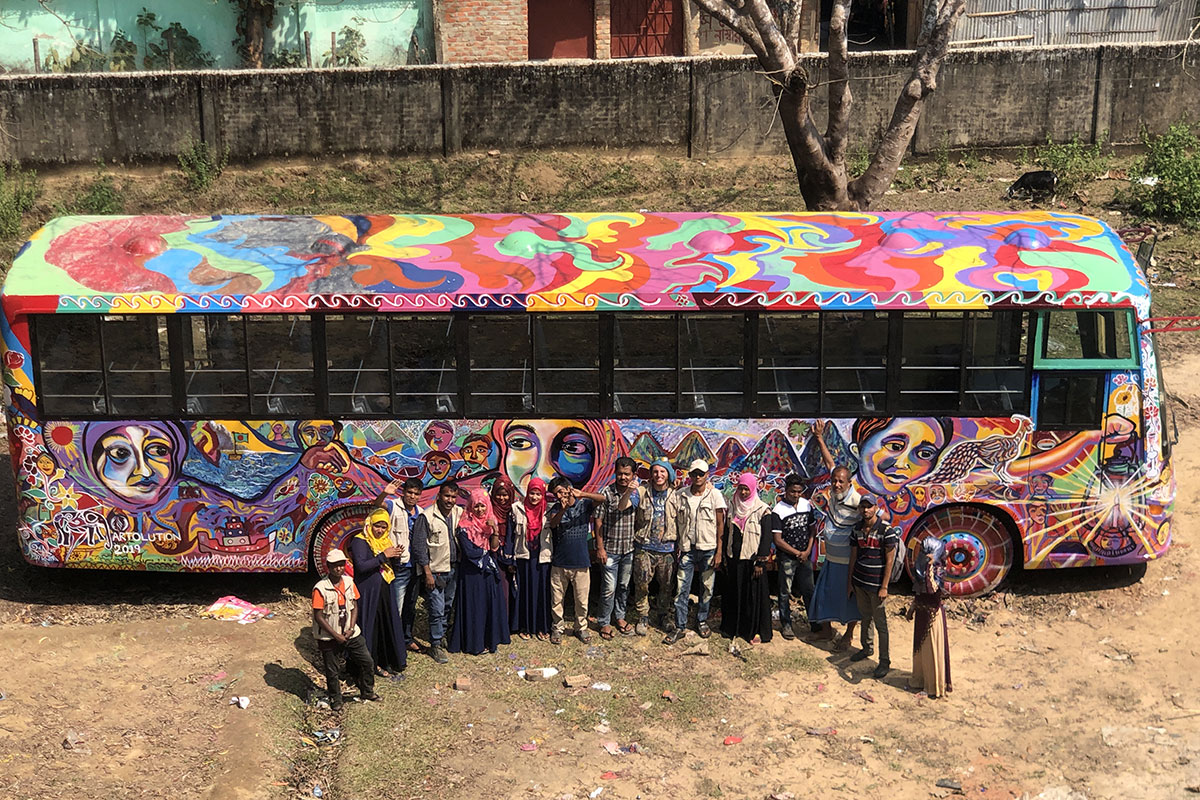
ARTISTS WITHOUT BORDERS The Artolution bus brought Rohingya children to Bangladeshi schools for the first time. (TC Archives)
Since the beginning of the COVID crisis in the United States, of course, Frieder has been unable to travel or even work at Artolution’s New York office. It’s been a difficult period, but throughout the spring he made the best of it by working fiercely hard from his apartment. At one point, he stayed up for 54 hours straight, taking calls from field workers who only had internet access at certain times, while completing his nearly 500- page dissertation on Artolution’s work with the Rohingya, titled “The Rohingya Artolution: Teaching Locally Led, Community-Based Public Art Educators in the Largest Refugee Camp in History.” Since 2017, he and his team have been conducting longitudinal interviews and focus groups — pre- and post-intervention — to determine whether the project is associated with changes in public behavior and social and emotional health outcomes. To that end, the research documents the evolution of the behaviors, perspectives and voices of the team of Rohingya Artolution teaching artists, and how to cultivate a locally led example of what is possible in an emergency context and understand the corresponding social change.
“It’s hard to qualify and say ‘Artolution did this,’ because we’re officially a ‘complementary program’ with the Red Cross, UNICEF, UNHCR and other health organizations. So we’re one of the factors and variables, but we’re not the key determinant.”
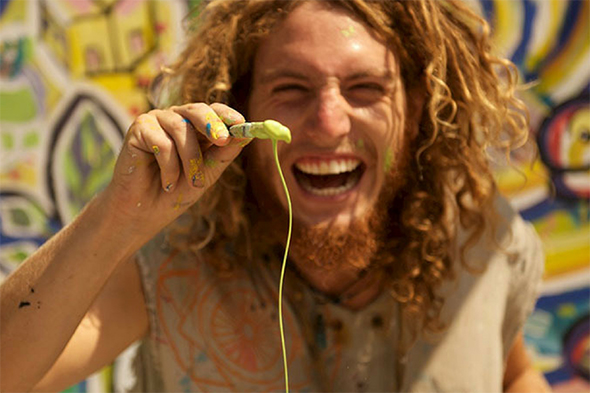
BOUNDLESS ENERGY During the pandemic, Frieder wrote his dissertation and, from his apartment, supervised field teams around the world. (Photo: TC Archives)
The broader goal, then — drawing on hundreds of interviews with the teaching artists, aid workers, parents and children — has been to validate Artolution’s methods for community-based art education, show that the project is promoting the UN’s goals for sustainable development, and document shifts in perspectives and behaviors of the Rohingya teaching artists.
“My focus really has shifted from ‘tracking the social impacts of our work’ to ‘what are the components to creating a sustainable model of community based public art education,’” Frieder says. “Which is a really different question, because now it’s about the needs and priorities of our teaching artists and their communities.”
With the recent spread of COVID in the Rohingya refugee camps, Frieder is deeply worried about his friends and co-workers there.
“Especially with all the emphasis on ‘America First,’ it’s so crucial to humanize these folks for others. We’re all so desensitized by the news.” The recent racial violence in the United States has added to his fears. But in a recent conversation, he described a moment in Bangladesh that continues to give him hope. The Artolution team was given permission to bring youth from the camp to visit a Bangladeshi school for the first time. While they were there, an eight-year-old Bangladeshi boy named Shumo raised his hand, asked to speak and walked to the front of the room.
“He said, ‘I’m a Buddhist, and I know that Buddhists in Myanmar have killed thousands of Rohingya people,’” Frieder recalled. “And he said, ‘We have a responsibility to treat you as human beings who have the same rights we do.’ All of our artists and our country manager were in tears. I was thinking, ‘In all of the lives of these Rohingya genocide survivors no one has quite said that, and now it comes out of the mouth of a little boy.’” He shook his head. “I really do believe that in the darkest places and moments, you find the most light and resilience.”
— Joe Levine
